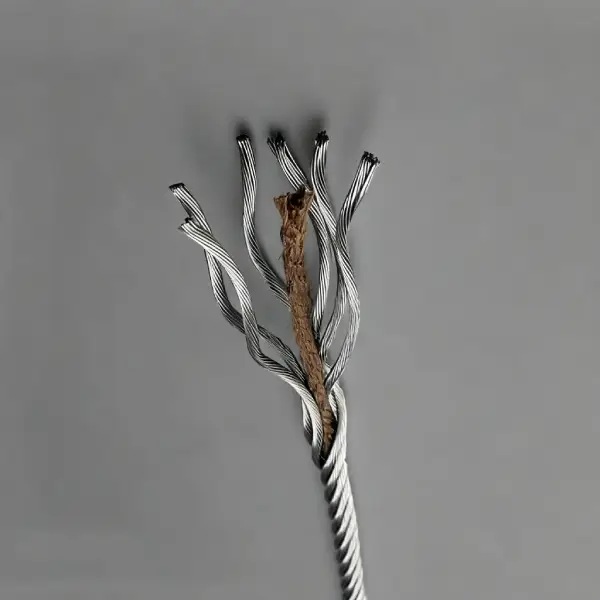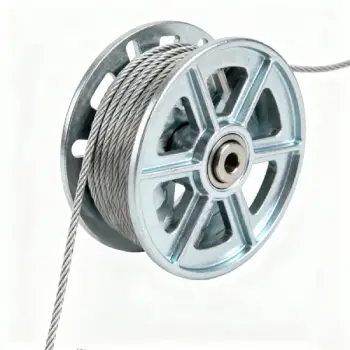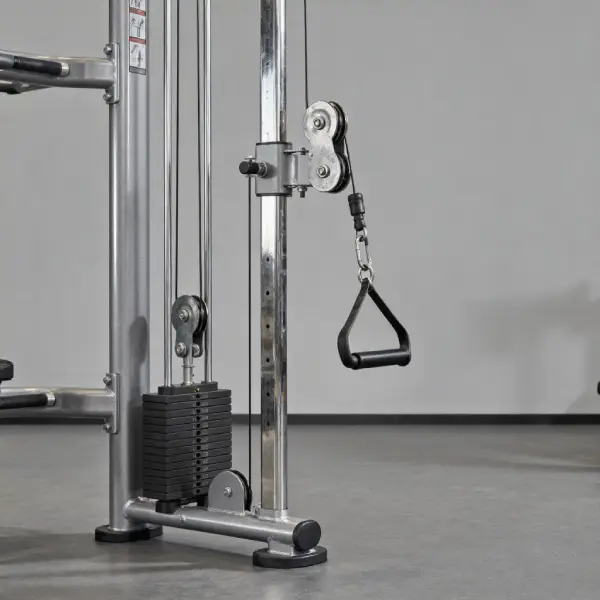When you’re choosing a wire rope for lighting, decoration, or control applications, you often wonder: “Do I need a softer wire rope and which wire rope bends better?”
For two wire ropes of the same diameter, a rope with more strands composed of thinner wires and a fiber core will be significantly more flexible. For example, a 6×19 rope with fiber core flexes much more than a 1×19 rope with steel core—despite being the same thickness—because its wires bend easier and the core allows more give.
1 Flexibility Comparison of Different Wire Rope Constructions
Here’s how common rope constructions stack up in terms of flexibility:
| Structure | Wire & Strand Count | Flexibility Level | Typical Use Cases |
|---|---|---|---|
| 1×19 | One strand of 19 wires | Very low flexibility (most rigid) | Structural supports, straight-span tensioning, where bends are minimal |
| 1×12 | One strand of 12 wires | Low flexibility, more than 1×19 but much less than multi-strand ropes | Architectural railing, minimal bend signage, fixed install lines |
| 1×7 | One strand of 7 wires | Low-moderate flexibility; more flexible than 1×19 < 1×12 < 1×7 | Small tension tasks, support braces, light decorative work |
| 7×7 | 7 strands × 7 wires each (49 wires) | Moderate flexibility; 1×7 < 7×7 < 7×19 | General suspension, guardrails, indoor lighting, signage with occasional bending |
| 7×19 | 7 strands × 19 wires each (133 wires) | High flexibility; the highest among these common types | Control cables, pulley systems, stage rigging, and decorative hanging where small bends or frequent movement are needed |
| Cable-laid / multi-rope laid together | Several wire ropes are braided or twisted together | Very high flexibility, more than 7×19 in many cases | Theater rigging, movable decorative systems, flexible signage where aesthetics + movement matter most |
Flexibility ranking (from rigid → flexible):
1×19 < 1×12 < 1×7 < 7×7 < 7×19 < Cable-laid
- Thinner wires bend more easily; fewer stresses per wire when the rope bends.
- More strands / more wires mean the rope surface becomes smoother and more compliant, especially around sheaves and small radii.
- For example, a 7×19 rope will flex much more easily around a pulley than a 1×19 of the same diameter. According to Bishop Lifting, 7×19 “is much more flexible than 7×7 and is better for pulleys, winches, dynamic applications where the rope bends repeatedly.”
2 Other Factors Influencing Wire Rope Flexibility
Besides structure, several other factors affect how easily a rope can bend:
Wire diameter & strand count:
Thinner wires = higher bending capacity. E.g., a rope with small wires (like in 7×19) will outperform thicker-wire versions (like 1×19) in bending cycles.
Core type:
Fiber core (FC): more flexible, can absorb lubricant, softer, better for applications with movement.
Independent Wire Rope Core (IWRC): much stronger core, resists crushing and heat, but is stiffer.
For instance, a 6×19 rope with a fiber core will flex more easily than a 7×19 rope with an IWRC of similar diameter.
Manufacturing process & materials:
The drawing process (how each wire is drawn, whether annealed or work-hardened)
Heat treatment
Lubrication during production or after installation
These determine how wires yield and how strands interact under bending.
3 Which Materials Are More Flexible (Stainless Steel, Galvanized, Carbon Steel)?
Material choice also plays a big role. Here’s a comparison:
| Material | Flexibility – General Trend | Pros / Cons |
|---|---|---|
| Low-carbon / mild carbon steel | Most flexible (softer, more ductile) | Pros: easy bending, low cost. Cons: lower corrosion resistance. |
| Galvanized Carbon Steel | Very similar flex to low-carbon steels; coating adds almost no extra stiffness | Pros: corrosion protection, good cost/value. Cons: coating can crack/scratch, and maintenance matters. |
| Stainless Steel | Less flexible due to alloy content (Cr, Ni) and higher hardness | Pros: excellent corrosion resistance. 316, especially for harsh environments. Cons: stiffer, higher cost. |
4 Fiber Core vs Steel Core Wire Ropes – Flexibility Differences

A fiber core (natural or synthetic) gives a rope more “give”. It cushions bends, holds lubricant, and reduces internal friction.
Steel core / IWRC adds strength (especially in high temperature or crush/abrasion environments), but at the cost of reduced flexibility and increased minimum bend radius.
Quick guide: If your application involves small pulleys, frequent bending, or dynamic movement (e.g., lighting wires, control lines), a fiber core rope is usually better. If you need strength, less elongation under load, and more resistance to crushing (e.g., static spans, structural supports), steel core / IWRC may be preferable.
5 How to Choose the Right Flexibility for Your Application
When choosing wire rope, the right flexibility isn’t magic—it’s matching several practical factors to your usage. Here are two key considerations + real examples:
- Bending frequency example: Think of a bicycle brake cable. Every time you squeeze the lever, the cable bends. If that bending happens thousands of times (daily over weeks), a rope with high flexibility (fine wires, many strands, fiber core) will last longer without becoming stiff or failing. If you choose a rope that’s too rigid, it might snap or fray near the lever after repeated use.
- Bend radius example (spooling/packaging): When wire rope is wound (spooled) on a reel or stored on a drum, the spool’s diameter matters. A rope of a certain diameter must use a spool (or reel) at least a certain size; otherwise, errors creep in: the rope may deform, lose vertical alignment, or place extra stress on outer wires. For instance, if you use a 3 mm rope but try to spool it on a very small reel, the outer layers will have much more bend, accelerating fatigue.
So, a practical decision guide you can follow:
- Define how often the rope will bend (daily, weekly, or rarely).
- Identify the smallest radius it must bend around (lever, pulley, spool) without damaging wires.
- Choose rope structure + core that fits those conditions: more strands, thinner wires, fiber core for frequent bending; stiffer constructions for static or straight runs.
6 Flexibility vs Durability – Understanding the Trade-Off

Flexibility and durability often live in tension: optimizing one can weaken the other. Here’s how they differ, relate, and what trade-offs you need to understand:
- Flexibility is about a rope’s ability to bend easily, especially around small pulleys or tight curves. Conditions that increase flexibility: many small wires, many strands, soft core (fiber), smoother coating, lighter material. A highly flexible rope is easier to install and less likely to snap under repeated bending.
- Durability refers to how long the rope holds up under wear, abrasion, crushing, and environmental stress. It depends on thicker outer wires, fewer, tougher wires, steel cores (IWRC), good lubrication, larger D/d ratios (sheave to rope diameter), and strong coatings. A durable rope resists damage from rubbing, sharp edges, and external pressure.
Trade-off examples:
- A 7×19 rope (steel core) is highly flexible and performs well in control cables or winches with frequent bending. However, its many thin wires wear faster under abrasion compared to constructions with thicker outer wires.
- A 1×19 rope is far less flexible, but it resists surface wear and maintains alignment under tension, which makes it the go-to choice for structural support, rigging, and guy wires.
Bending fatigue resistance increases when you increase the D/d ratio (sheave diameter divided by rope diameter) and reduce load; ropes that are forced around too tight sheaves degrade quickly. Also, while fatigue resistance improves with many wires and strands, abrasion resistance improves with fewer, larger outer wires — showing how durability and flexibility pull in opposite directions.
So there’s no “perfect rope” for all cases — it’s about matching performance to your needs.
7 Is Flexibility the Only Important Metric? What Opposes It

Flexibility is great, but it isn’t everything. There are other wire rope characteristics that sometimes oppose flexibility—if you push flexibility up, some of these others may go down. To choose well, you need to balance.
Here are some of the key “opposite” or complementary metrics to flexibility, what they are, and how they matter:
- Stiffness / Rigidity — How much the rope resists bending or deflection under load. A stiff rope is less flexible but holds its shape better, resists sagging, and transmits force with less loss. (“Stiffness” is often expressed as bending stiffness or axial stiffness in technical guides.)
- Durability under abrasion and crush — More flexible ropes usually have thinner wires, which wear faster when rubbing against surfaces, sheaves, or drums. A thicker wire in each strand (or a denser construction) resists abrasion, but sacrifices some flexibility.
- Fatigue resistance — How many bending cycles a rope can endure before failure. Frequent bending or movement stresses the wires. Ropes with many thinner wires + soft core may bend often, but if fatigue resistance is low, they’ll fail sooner.
- Strength and load capacity — More flexible designs may reduce breaking strength for the same diameter or make the rope less stiff axially. For heavy loads or tensioned installation, rigidity and breaking strength may matter more than how “smoothly” it bends.
- Wear, deformation, and stability — Ropes with less stiffness may deform under load, flatten, or suffer from irregular wear. Also, in spooling or pulleys, too flexible ropes may not seat correctly or may be damaged.
Summary
In short, when you keep wire ropes at the same diameter, flexibility will largely come down to structure, core type, and wire count. Ropes with many fine wires and a soft or fiber core (like 6×19+FC) will bend much more easily than ropes with fewer, thicker wires and steel cores (like 1×19). There’s always a trade-off: more flexibility often means slightly less abrasion resistance or crush strength.
For you, that means:
- If your installation requires frequent bending, small pulleys, or dynamic movement (lighting fixtures, control cables, decorative hanging), then prioritize ropes like 7×19 or 7X7.
- If your application is mostly static, under tension, or in harsh environments, then a more rigid construction (1×19 or 1×12) might offer better performance.
Finally, don’t forget the details: finish, material, and maintenance matter. A well-manufactured 7×19 rope with proper coatings and good upkeep can outperform a poorly made steel-core rope, even if that rope has theoretically higher strength.
